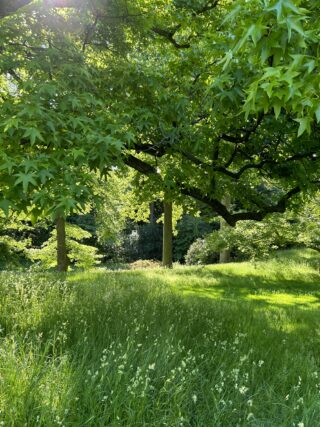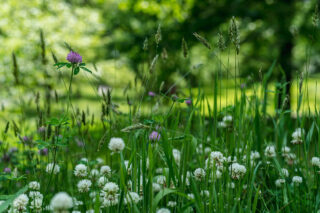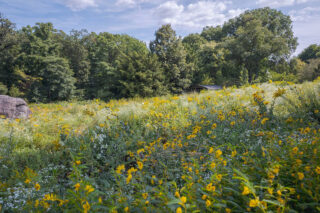Better Lawns:
How to Downsize Your Lawn
What’s in a lawn? Well, grass—lots of it. But there’s a lot more to dig into with this familiar suburban staple. Though the picture-perfect lawn seems harmless enough, it impacts our environment much more than you think. And once you start looking into alternatives, well—the grass is usually greener on the other side.

The horticultural ideal of the lawn was brought to America via Britain, whose pastoral landscapes inspired the planned, controlled, and vast expanse of a green lawn. Though wide meadows and fields grow well in the cool, damp climate of Britain, a monocultural lawn doesn’t bode well in America’s diverse array of ecosystems. Therefore, keeping up a lawn is costly both financially and environmentally—a large quantity of water, herbicides, fertilizer, and maintenance are needed to keep them perfectly manicured and green. Pollution from harmful chemicals and excessive fertilizer products will leak into groundwater, rivers, and oceans. Importantly, lawns don’t provide food or habitat for wildlife, especially pollinators.
One of the most crucial ways we can help our environment is by limiting our water usage. About 30 percent of the 320 gallons the average American family uses daily is devoted to outdoor uses like watering lawns and gardens (Unites States Environmental Protection Agency). Half of the water Americans use outdoors is wasted due to inefficient watering systems, evaporation, and over-watering. A 1,000 square foot lawn could require as much as 20,000 gallons of water per year! With that much water, you could serve 320,000 8-ounce glasses of water, take 800 10-minute showers, and fill 500 bathtubs, according to the Dodger Stadium in Los Angeles, which has an ice rink that takes 20,000 gallons to fill. For our local New Yorkers, Madison Square Garden’s ice rink takes about half of that.

Water is a renewable resource, but not quickly replenishable. Fresh water makes up only about 3% of Earth’s water, and most of it is locked up in many forms that are unusable to various populations—such as ice caps, glaciers, groundwater, water vapor, and untreated water. Our overuse has caused water scarcity in many parts of the world, and has also harmed ecosystems and species that rely on natural water sources to survive day-to-day. While draining your pockets, irrigation also drains natural water sources: the cost of water has soared, especially for states in the Southwest, where the hot and arid climate necessitates a large quantity of water for lawn upkeep. This is in turn impacting freshwater resources like rivers, dams, and lakes.
But lawns have been around for centuries—how do we shift the narrative to include more beneficial, colorful, and diverse alternatives? Even small changes can make a big impact. Begin by downsizing, so less of your yard is devoted to solely grass, and plants that require less water and upkeep can flourish.
How to downsize your lawn:
- One way to do this is to allow your lawn to “renature” itself. Let whatever chooses to seed itself take over. This can turn your lawn into a beautiful tapestry of native plants! You will still need to mow once a year or so to prevent woody plants from taking hold. Keep an eye on encroachment of invasive plants and manage them early.
- Try to mow less—mowing just once a year is enough to prevent most woody plants from growing. Use a manual mower if possible, to reduce emissions.
- Convert some lawn space to something more productive such as a vegetable, herb, or wildflower garden. This will not only benefit biodiversity, but will also be a wonderful hobby for you or your family to spend time outside!

- Try using ground covers or organic mulches, stepping stones, or other dirt walkways that will add to your landscape without taking up water.
- For some high traffic areas, turf lawn is the most durable and practical solution. For any remaining lawn areas, use an appropriate grass mixture, suited to the characteristics of your location and growing conditions, so that less chemical and water intervention is necessary.
For more tips and a list of low maintenance plantings, get insight with the PRFECT EARTH PRJCT, an organization that promotes nature-based, toxic-free land care practices, or read this post from the Plant Docs in the Mertz Library. Have a question? Ask the Plant Docs here.
Want to learn even more? Check out our episode of Plant People, NYBG’s podcast, with guest Edwina von Gal.
SUBSCRIBE
Enter your email address to subscribe to this blog and receive updates on new posts.











